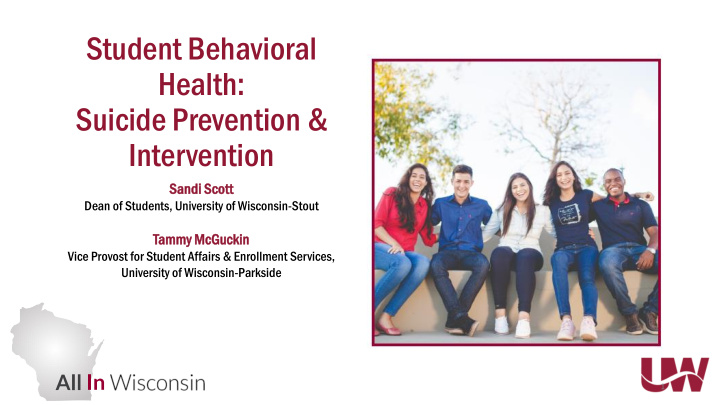



Student Behavioral Health: Suicide Prevention & Intervention Sandi di Scott Dean of Students, University of Wisconsin-Stout Tammy mmy McGuc uckin kin Vice Provost for Student Affairs & Enrollment Services, University of Wisconsin-Parkside 1
National Landscape
Key Issues Students are reporting Anxiety iety and depre ress ssion ion are the Behavioral health issues incre reased ased behavior avioral al health lth most common student significantly impact act the issues and seeking help in behavioral health concerns, and academ demic ic success s and record numbers are increasing; suicide de is also on reten ention tion of our students the rise
Behavioral Health A state of well-being in which every individual realizes his or her own potential, can cope with the normal stresses of life, can work productively and fruitfully, and is able to make a contribution to her or his community. Source: World Health Organization (WHO), College Stats, 2018
Depression A behavioral health disorder characterized by persistently depressed mood or loss of interest in activities, causing significant impairment in daily life. Increases risk for suicide. Source: World Health Organization (WHO), National College Health Assessment (NCHA), Spring 2015
Depression: UW System vs. Nationwide National Trends Depression Diagnosis or Treatment 50% 20% 18% 18% 16% 42% 14% 41% 14% 12% 40% 12% 11% 10% 10% 33% 8% 2010 2012 2014 2016 2018 30% 23% UW SYSTEM ‘15 UW SYSTEM ‘18 20% 18% NATIONAL ‘18 16% UW SYSTEM ‘15 UW SYSTEM ‘18 NATIONAL ‘18 10% UW SYSTEM ‘15 UW SYSTEM ‘18 NATIONAL ‘18 0% Felt so depressed it was difficult to function Diagnosed or Treated (1+ times in last 12 months) (last 12 months) Source: National College Health Assessment (NCHA), Spring 2015, Spring 2010- 2018
sion – UW System Demographic Groups Dep epres ession 80% 73% 67% 70% 61% 60% 47% 50% 45% 44% 44% 43% 40% 34% 34% 30% 25% ty c Minority 23% 22% nder gende 20% Disability ty 13% Transge Ethnic Veteran an Female le LGBQ 10% Male LG 0% Felt lt so so dep depre ress ssed d it it was was dif difficul icult to f t to functi unction on (1+ + time imes in las s in last 12 m t 12 mont onths) hs) Di Diagnose nosed or or Tre reat ated d (las last 12 2 mont months) hs) Source: NCHA-Spring 2018
Suicide and Self-Harm • Suicide is the act of ending one’s life, most often as a result of depression or other mental illness. • Self-Harm is characterized by deliberate acts to wound one’s self. Source: American Psychological Association (APA), 2015, College Stats, 2018
Suicide and Self Harm (last 12 months) 14% 13% ≈22,000 12% students 12% 9% 10% 9% 8% 7% 8% 6% UW SYSTEM ‘18 UW SYSTEM ‘15 ≈3,700 NATIONAL ‘18 students 4% 2.1% UW SYSTEM ‘15 UW SYSTEM ‘18 1.7% 2% NATIONAL ‘18 1.3% 0% Seriously considered suicide Attempted Suicide Self-Injured Source: NCHA-Spring 2015 and NCHA-Spring 2010- 2018
Suicide ide & Self f Harm m (last t 12 12 months) ths)- University of Wisconsin System Demographic Groups 35% 31% 29% 30% 28% 25% 23% 21% 20% 16% 15% 15% 12% 12% 12% 11% 10% ty c Minority 9% 10% nder gende 6% Disability ty 5% 5% Transge an Veteran Ethnic 5% Female 3% 3% Male LGBQ 2% 2% 1% 0% Serio Se rious usly C ly Consid nsidered red Su Suic icide ide Self-I Se lf-Inju njured red Attem At empted ted Su Suici icide de Source: NCHA-Spring 2018
Counseling Center Utilization & Enrollment Trends UW Enrollment Counseling Clients Counselors 60% 55% 55% 50% 40% 30% 20% 19% 10% 0% -2.5% 5% -10% 2010 2011 2012 2013 3 2014 2015 5 2016 6 20 2017 2018 Sources: UW System Fact Book; UW System Counseling Directors
Impact on Health Services • Student behavioral health Because of limited d access ss Access s to • • • Students request issues accounts for up to one to psychiatric services, psychotr hotropi pic c docume ument ntat ation ion from third d of student visits to UW students are increasingly medicati cation on Health Services to be health services centers; relying on health services assessm sment nt and used for disability for support management is a accommodations • Almost one half f of visits to a struggle UW health services center also involve a behavioral health issue Source: UW System Health Directors, 2018
Behavior Intervention Teams • Multidisciplinary teams of campus consultants trained in risk/threat assessment. • Serve as a “vortex” for receiving and analyzing critical behavioral concerns. • Assess safety risk (to self and others) and coordinate/manage response.
Campus response to a student suicide attempt All threats are taken seriously Initial conversations and appropriate interventions Safety assessments Family notification if deemed necessary Care and attention given to others who may be impacted
Campus response to student death by suicide Support for immediate Impact can occur for Support for family circle (roommates, an extended period and campus faculty advisor, of time community teammates, etc.)
College as a Protective Factor College students are less likely to die by suicide than their non- student peers. Source: Silverman et al., 1997; Drum et al., 2009)
A Framework For Student Wellbeing Focus Scope Tier 1 • Provision of timely • Select students; most at-risk for services and support for Critical Behavioral Health self-harm or suicide students who are in & Crisis Response grave psychiatric Services distress • • Programs and services aimed at Students identified as part of a helping students experiencing high “vulnerable” population Tier 2 rates of stress or behavioral issues Targeted Interventions • • Majority of students; Preventative efforts to teach students Tier 3 experience some stress how to create and maintain healthy, but do not require balanced lifestyles Creating Healthy Learning counseling or an Environments intervention Source: Adapted from the University of California Student Mental Health Resources & Promising Practices Report, 2006
Recommend
More recommend